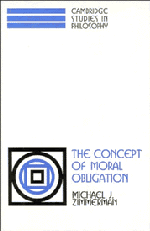Book contents
- Frontmatter
- Contents
- Preface
- Acknowledgments
- 1 Groundwork: Some distinctions
- 2 Moral obligation: An analysis
- 3 The dynamics of obligation
- 4 Conditional obligation
- 5 Prima facie obligation
- 6 Actualism and possibilism
- 7 Dilemmas
- 8 Supererogation
- 9 Cooperation
- Postscript
- Appendix: List of propositions
- List of works cited
- Index of names
- Index of subjects
3 - The dynamics of obligation
Published online by Cambridge University Press: 18 February 2010
- Frontmatter
- Contents
- Preface
- Acknowledgments
- 1 Groundwork: Some distinctions
- 2 Moral obligation: An analysis
- 3 The dynamics of obligation
- 4 Conditional obligation
- 5 Prima facie obligation
- 6 Actualism and possibilism
- 7 Dilemmas
- 8 Supererogation
- 9 Cooperation
- Postscript
- Appendix: List of propositions
- List of works cited
- Index of names
- Index of subjects
Summary
“OUGHT” AND “CAN”
There are few propositions more widely discussed in the literature on philosophical ethics than the proposition that “ought” implies “can.” I have noted that my account of obligation implies this proposition to be true, indeed to be analytic, when understood as follows:
(2.46) if S ought [at T in W] to do A [at T′], then S can [at T in W] do A [at T′].
That my account implies the truth of this proposition will no doubt incline many readers to reject the account.
In this section I shall consider a number of reasons for denying (2.46), proceeding from objections that seem to me quite weak to objections that seem to me stronger (but still unsuccessful). In Subsection 2.2.4 I distinguished two senses of “can” such that “ought” implies “can.” The weaker sense was just that of personal possibility or accessibility; it is this sense of “can” that I have employed in this work. The stronger sense was that of being free to perform an action (stronger in that a person's being free to perform an action implies, but is not implied by, that action's being personally possible for that person). In what follows, it is “can” merely in the sense of personal possibility that is explicitly at issue – except when alternate possibilities are discussed in Subsection 3.1.5, where it is “can” in the sense of “free to” that is at issue.
- Type
- Chapter
- Information
- The Concept of Moral Obligation , pp. 79 - 113Publisher: Cambridge University PressPrint publication year: 1996



